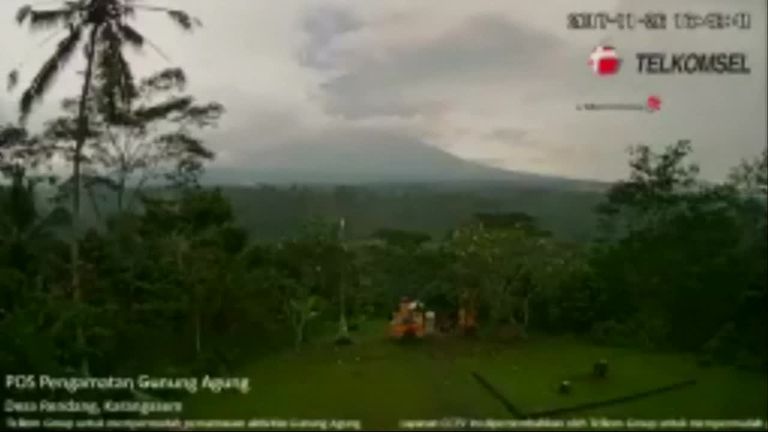Mount Agung: What's happening below the volcano's surface?
Get up to speed with these volcanic facts as pressure builds and Mount Agung threatens to blow.
Monday 27 November 2017 17:38, UK
After months of rumbling, Mount Agung in Bali looks to be on the verge of a major eruption.
Forty-thousand people have been evacuated and a six-mile exclusion zone declared. It means a further 100,000 will be forced from their homes.
Here's what you need to know about what's going on below the surface.
:: What makes a volcano erupt?
Mount Agung straddles Earth's tectonic plates and now magma - underground molten rock - is forcing its way to the surface.
"Because the magma is very viscous, the gas has a hard time getting out, so the pressure builds up," explains University of Leeds volcanologist Dr David Ferguson.
"It has to get out somehow, so that can end in an explosion."
Many of the smoke plumes from the volcano are caused by underground water heated by the magma emerging as steam with bits of ash, rock and glass.
That is a likely precursor to magma fully coming to the surface.
Gas forces its way to the vent of the volcano under high pressure, bringing magma with it that explodes from the crater.
Dr Ferguson compares the situation to a build up of gas in a fizzy drink, which explodes from the top when given a chance to burst out.
But volcanic bursts are not necessarily violent eruptions.
"It's a matter of whether that gas can escape passively, through bubbling out through magma and through cracks in the volcano, or whether it builds up to such a volume of gas that it bursts out explosively and casts a very high column of fragmented ash high into the AG百家乐在线官网," explains Professor David Rothery, a volcanologist at the Open University.
:: Why do volcanic eruptions ground planes?
:: What happens during an eruption?
The eruption could be spectacular - and deadly.
Magma fragments will reach the surface with ash, rocks and cooled, solidified lava - known as "volcanic bombs" - that could be thrown hundreds of metres from the crater.
Most dangerous, however, are the pyroclastic flows the eruption might bring.
These clouds of gas emerge from the crater at 1,000C and barrel down the slope, carrying rocks and ash.
They can be heavy enough to destroy houses and engulf whatever is in their path.
"They're really inescapable," says Dr Ferguson. "They look like clouds of ash, but they're actually hot ash, gas and rock.
Ash clouds also conduct electricity, so when they come into contact with power lines they can bring down the grid.
And when it rains, the water picks up ash and molten rock to become thick, muddy lahars flows, persisting for months after the eruption itself.
:: Has Mount Agung erupted before?
The last major eruption was in 1963 and killed more than 1,000 people.
Plumes of ash reached up to 16 miles above sea level and most deaths were caused by pyroclastic flows.
:: Why is it happening now?
Mount Agung is thought to erupt about once every century and mostly remains calm - although there have been several earthquakes reported in the last decade.
The run-up to an eruption depends on the build up of magma from much deeper below the Earth's crust.
Because it is less dense than higher-up magma it forces its way up, increasing pressure closer to the surface and creating more gas.
"The magma from below is generally very hot and has a lot of gas in it," Dr Ferguson says.
"If you inject that into some old magma you can rejuvenate it, and make it eruptable."
He compares the process to blowing up a balloon, which can only expand to fit so much gas before it explodes.
The volcano's magma chamber inflates, pressuring the rock around it until as now, the rock eventually breaks.







